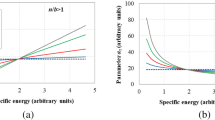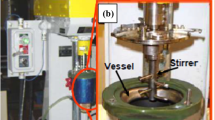Abstract
In a series of Julius Kruttschnitt size-dependent breakage models, the cumulative percentage passing 1/10 of the initial size is used as a fineness indicator for scientific research and the selection of grinding equipment. However, in industrial practice, it is quite customary to use the mass percentage passing 75 μm as the indicator. In this paper, based on the energy-particle size model, quartz and calcite, two materials with distinctly different hardness, were used as test samples in a conical ball mill. At the same specific energy, the value of the cumulative percentage passing 1/10 of the initial size decreased while that of the mass percentage passing 75 μm increased with finer feed size. The experimental test values of the mass percentage passing 75 μm have a good linear relationship with the model predictions, which suggests that the particle size energy relationship of the mass percentage passing 75 μm and Ecs can be used instead of the cumulative percentage passing 1/10 of the initial size and Ecs. By building family curves, when particle size x < 300 μm, the family curve can be well fitted, and the fine particle size distribution of the whole product can be reconstructed.









Similar content being viewed by others
References
Shi FN, Kojovic T (2007) Validation of a model for impact breakage incorporating particle size effect. Int J Miner Process 82(3):156–163
Prziwara P, Hamilton LD, Breitung-Faes S (2020) Evaluation of the capturing of dry fine particles between grinding media by drop-weight tests. Powder Technol 363:326–336
Farhad F, Vladimir J (2018) Quantifying variability of ore breakage by impact – implications for SAG mill performance. Miner Eng 127:81–89
Zhao B, Yang JL, Zhan XP (2021) Differential design based on double pendulum anti-galloping device for important line – ScienceDirect. Energy Rep 7:613–618
Shi FN, Kojovic T, Larbi-Bram S (2009) Development of a rapid particle breakage characterisation device – the JKRBT. Miner Eng 22(7–8):602–612
Shi FN, Xie W (2015) A specific energy-based size reduction model for batch grinding ball mill. Miner Eng 70:130–140
Kim HN, Jin WK, Min SK (2019) Effects of ball size on the grinding behavior of talc using a high-energy ball mill. Minerals 9(11):668
Duan J, Lu Q, Zhao Z (2020) Grinding behaviors of components in heterogeneous breakage of coals of different ash contents in a ball-and-race mill. Minerals 10(3):230
Zuo W, Shi FN, Manlapig E (2015) Pre-concentration of copper ores by high voltage pulses. Part 1: Principle and major findings. Miner Eng 79:306–314
Wu C, Liao NF, Shi GM (2018) Breakage characterization of grinding media based on energy consumption and particle size distribution: hexagons versus Cylpebs. Minerals 8(11):527–540
Zhang SY, Zhuang ZQ, Wang H (2021) Separation of wolframite ore by froth flotation using a novel “crab” structure sebacoyl hydroxamic acid collector without Pb (NO3)2 activation. Powder Technol 389:96–103
Liu W, Peng X, Liu W (2020) Effect mechanism of the iso-propanol substituent on amine collectors in the flotation of quartz and magnesite – ScienceDirect. Powder Technol 360:1117–1125
Zhu X, TAO, Y. (2019) Particle migration regularity in compound force field of enhanced gravity concentrator. Int J Coal Prep Util 39(4):219–231
Shi FN, Zuo W (2014) Coal breakage characterisation – part 1: breakage testing with the JKFBC. Fuel 117:1148–1155
Yi C, Pei Y (2022) Experimental study and application of grinding medium ratio optimization in Jiaojia Gold Mine. Gold Sci Technol 30(1):122–130
Jankovic A, Valery W (2013) Closed circuit ball mill – basics revisited. Miner Eng 43–44:148–153
Petrakis E, Komnitsas K (2022) Effect of grinding media size on ferronickel slag ball milling efficiency and energy requirements using kinetics and attainable region approaches. Minerals 12(2):184
Shi FN, Xie W (2016) A specific energy-based ball mill model: from batch grinding to continuous operation. Miner Eng 86:66–74
Ngonidzashe C, Murray MB (2021) Milling studies in an impact crusher I: kinetics modelling based on population balance modelling. Minerals 11(5):470
Munn T, Morrell S, Morrison RD (1999) Mineral comminution circuits: their operation and optimisation. J Exp Nanosci 10(3):1–8
Acknowledgements
The authors also thank the Jiangxi Key Laboratory of Mining Engineering.
Funding
This work is financially supported by the National Natural Science Foundation of China (51764015).
Author information
Authors and Affiliations
Contributions
C. W. and N. L. conceived of and designed the experiments; N. L. and L. Z. prepared the samples and performed the experiments; C. W. and N. L. analyzed the data; C. W., N. L., G. S., and L.Z. contributed to the writing and revising of the paper.
Corresponding author
Ethics declarations
Conflict of Interest
The authors declare no competing interests.
Additional information
Publisher's Note
Springer Nature remains neutral with regard to jurisdictional claims in published maps and institutional affiliations.
Supplementary Information
Below is the link to the electronic supplementary material.
Rights and permissions
Springer Nature or its licensor (e.g. a society or other partner) holds exclusive rights to this article under a publishing agreement with the author(s) or other rightsholder(s); author self-archiving of the accepted manuscript version of this article is solely governed by the terms of such publishing agreement and applicable law.
About this article
Cite this article
Tong, J., Wu, C., Liao, N. et al. An Energy-T75 Size Reduction Model for Ball Mills. Mining, Metallurgy & Exploration 40, 131–139 (2023). https://doi.org/10.1007/s42461-022-00704-y
Received:
Accepted:
Published:
Issue Date:
DOI: https://doi.org/10.1007/s42461-022-00704-y




